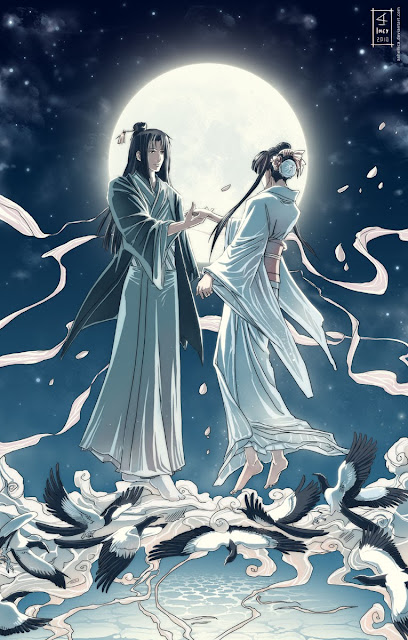 |
| Punchinello Punch of dA, Tanabata Myth |
August 13th of this year was the seventh day of the seventh month in the lunar calendar and the day of the Double Seventh Festival--Qixi or the Magpie Festival, Tanabata in Japan. It is the remembrance of the once-a-year reunion of two lovers over the river of light known as the Milky Way.
The story of the weaver girl and the cowheard is a tale belonging to Faerie through-and-through. It originated in the stars and constellations, like the Greco-Roman myths, and there are at least a few similar stories accounted for in Ovid's Metamorphoses. Orpheus comes close, but I can't think of a western myth quite as thoroughly fairy tale-ish as the one belonging to Qixi. Perhaps the long delay of Christianization in the east kept the transition between Chinese myth and folklore fluid. The motiffs of the poor peasant and the wicked mother figure; the stolen garment and the fairy wife; the enchanted speaking beast and the helpful animals--these are common and fondly thought of. Indeed they are a signpost to any watchful traveler--to tread softly, speak kindly, not look directly into the eyes of a stranger, for the Otherworld is near.
 |
| AnHellica of dA, Tanabata, source |
There are many versions of the myth, of course, but I have combined my favorite elements to tell the tale as follows:
ONCE upon a time, there was a poor cowheard named Niulang who lived with his elder brother. His sister-in-law was very cruel to him, and she inevitably drove him out.
Now the Queen of Heaven had seven daughters who descended from the sky to go bathing. Niulang happened to be out tending his herd, when he saw them and retrieved one of their discarded robes. When the fairy women finished their baths and dressed to return, the youngest could not find her clothing. Then the cowheard emerged and asked her to marry him. Her name was Zhinü, the weavergirl, and she saw that he was strong, kind, and handsome; and she agreed. They had two children and lived in happiness.
Many years passed that were as mere days in heaven. So when the Queen Mother noticed her youngest daughter missing, she was livid. She retrieved her and set Zhinü to work, weaving clouds at her loom. Niulang and his children did not know where she had gone, and were desolate.
 |
| artist unknown |
It happened that the cowheard had an ox, who told his master to slaughter him and put on his hide in order to find his wife. The cowherd wept bitterly but did as his loyal beast bid him. When he put on the magic hide, he and his children flew to heaven and reunited with their wife and mother. But the Queen of Heaven took out her hairpin and drew a line between them. The line grew and became a silver river dividing the fairy weaver and her mortal family. That river of light is the Milky Way; Zhinü is the star Vega; and her husband is Altair, with his two star-children, Beta Aquilae and Gamma Aquilae, flanking either side of him.
Once a year, the magpies take pity on them and fly up to heaven to make a bridge, so that the husband and wife may be reunited for a single night.
While maternal separation closes summer in the far east, it's appropriate that its opposite, maternal reunion, is celebrated in the western hemisphere. Today, the 15th of August, is the Feast of the Assumption of Mary, according to the Gregorian calendar. Orthodox tradition holds that Mary, the mortal woman who became the Mother of God, was crowned Queen of Heaven by her divine Son upon arrival. Where Zhinü and her goddess mother are at odds, the Virgin Mary reconciles.
 |
| artist unknown, source |
The paradox of reunion and separation holds itself well; each element opposing and suspending each other, like two poles of a magnet--or perhaps different sides of the same sphere, for both heavenly women obtain a joyous meeting with their Beloved and Offspring in heaven.
 |
| artist unknown |
I leave the last word to Masha:
August is a month for magic--a month of otherland wanderings and paths that may not come again . . . paths leading the Virgin each year back to her Son and me to the hidden places of wood and stream. . .
. . . I can't help but feel sad to see the end and the beginning.


I. Loved. This.
ReplyDeleteThe summer triangle of Vega/Altair/Deneb is one of my favorite things in the night sky. I'd heard this fairy tale before, but never heard it applied to the specific stars with the Milky Way/river of light between them.
Beautiful post. And beautiful retelling.